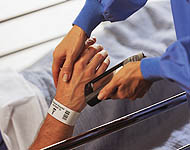Recent legislation and regulatory provisions designed to escalate U.S. implementation of electronic health record (EHR) systems have elevated the status of barcoded patient wristbands to that of essential technology. This is just one of the revelations I gleaned from the recent Zebra Technologies white paper, It’s All in the Wrist: Improving Patient Safety with Barcode Wristbands. Although the U.S. Health Information Technology Committee (HITC) will not complete the next EHR phases until 2013 and 2015, it’s increasingly clear that barcode medication administration (BCMA) will play integral roles in those systems.
As Zebra’s white paper reveals, human error in the healthcare industry has the potential to result in horrifying personal tragedy, not to mention crippling economic losses, and, in the case of the healthcare industry, much of that error is directly attributable to outdated and poorly administered wristband technology
To quote the paper:
“Checking the ‘Five Rights’ —
- Right Patient
- Right Medication
- Right Dose
- Right Time
- Right Method of Administration
— prevents most medication errors.”
I was surprised to learn just how frequently failure to confirm that first, most-basic Right – the Right Patient – results in adverse outcomes.
Integrating the use of bar-coded patient wristbands into automated medication administration systems is an obvious, essential step in ensuring that all medications are administered accurately and that the electronic medication records (eMAR) envisioned by the HITC’s ongoing EHR project accurately report that reality.
Zebra offers the following, deceptively simple scenario as a typical usage of bar-coded patient wristbands: The administering nurse first identifies the patient by scanning his or her wristband with a barcode scanner linked with or integrated into a mobile or bedside computer. The nurse next scans the medication barcode allowing system software to confirm whether the medication should be administered to that patient at the specified dosage and using the specified method of delivery. The nurse then scans his or her own badge to identify and record who administered the medication. Following this simple, repeatable procedure automates reliable confirmation of the Five Rights.
The Zebra white paper also discloses these not-so-fun facts: The mean rate of adverse drug events in hospitals was measured by the FDA at 4.3 % (of a range of from 2.4 to 6.5 %) and an average cost of $2,257 per event, translating to a cost per patient admission of an astounding $97.
Which should lead most Healthcare-IT pros to ask, how many patients does my facility admit on an average day?
For further reading:
U.S. Department of Health & Human Resources; Agency for Healthcare Research and Quality
- Using Barcode Medication Administration to Improve Quality and Safety
- Prevention of Misidentifications













